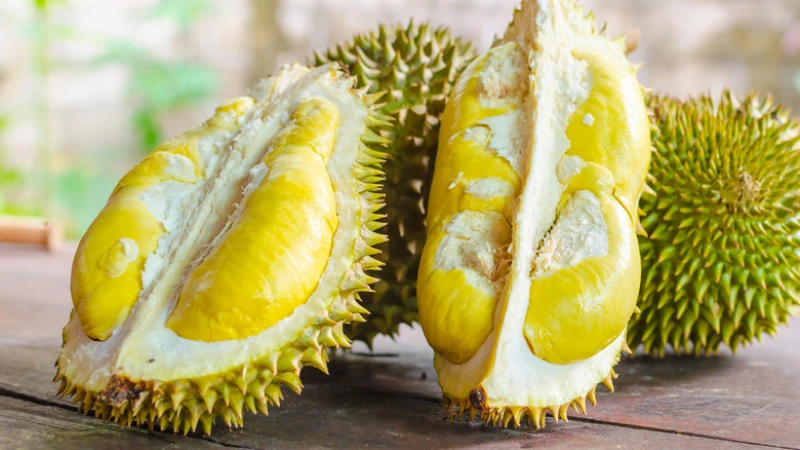Have you ever come across a food that made your nose wrinkle in both disgust and curiosity, yet people around you couldn’t get enough of it? Well, get ready to embark on a fascinating journey into the intriguing world of smelly foods – the ones that may not have the most appealing aroma but are loved by many despite their pungency. So, hold your breath (figuratively, of course) as we delve deeper into the aromatic depths and explore the top 10 smelly foods from around the globe.
Discover their origins, traditional preparation methods, and even some surprising health benefits associated with these olfactory adventures. Get ready to tantalize your taste buds and expand your culinary horizons as we delve into the fascinating world of smelly foods and how you can truly enjoy them!
Must Read: Does Durian Taste As Bad As It Smells?
1. Durian
- Description: Durian, known for its strong and distinctive odor, is often described as a combination of onions, garlic, and tropical fruit, which can be an acquired taste for some. However, don’t be discouraged by its initial aroma! Once you get past its spiky exterior, you’ll discover a rich and creamy flesh that resembles custard, with a flavor that is truly unique and delicious. The creamy texture and intense taste of durian make it an extraordinary fruit that is worth experiencing at least once in a lifetime.
- Origin: Durian is native to Southeast Asia, where it has been cultivated and enjoyed for centuries. This exotic fruit is highly prized in countries like Thailand, Malaysia, and Indonesia, where it is often considered the “king of fruits.”
- Tips: To fully appreciate durian, consider pairing it with complementary flavors like chocolate, which adds a delightful contrast to its richness. Alternatively, incorporating durian into desserts such as ice cream or pancakes can elevate your culinary experience to a whole new level. Embrace the creamy texture and let your taste buds embark on a gastronomic adventure with this extraordinary fruit.

2. Kimchi
- Description: Kimchi, a traditional and iconic dish in Korean cuisine, is a delightful blend of fermented cabbage, garlic, ginger, and chili peppers. Through the process of fermentation, this delectable condiment develops a distinctive spicy and sour aroma that tantalizes the senses. Beyond its pungent smell, kimchi offers an explosion of flavors that effortlessly elevate any dish, providing a harmonious balance of tanginess, spiciness, and umami goodness.
- Origin: Hailing from Korea, kimchi has been an integral part of the country’s culinary heritage for centuries. Its origins can be traced back to ancient preservation techniques, where the fermentation process was employed to preserve the harvest and sustain the population during long winters. Today, kimchi continues to be deeply rooted in Korean culture, cherished not only for its taste but also for its health benefits and symbolic significance.
- Tips: Unlock the full potential of kimchi by treating it as a versatile condiment that can enrich the flavors of countless meals. Embrace its vibrant presence in stir-fries, rice bowls, or noodle dishes, where the combination of textures and flavors creates a culinary symphony. For those seeking a diverse gastronomic experience, venture beyond traditional cabbage kimchi and explore tantalizing variations such as radish kimchi or cucumber kimchi. Immerse yourself in the rich tapestry of Korean cuisine and let kimchi take your taste buds on a remarkable journey.
3. Blue Cheese
- Description: Blue cheese is known for its distinct smell and tangy flavor. It’s a cheese variety that has veins of blue mold running through it, giving it a strong aroma. This cheese is an acquired taste, but once you develop a liking for it, you’ll find it to be incredibly delicious.
- Origin: Various regions
- Tips: Pair blue cheese with fruits like pears or apples for a delightful combination of sweet and tangy flavors. Use it in cooking to add richness to sauces or dressings. Enjoy it with a glass of wine for a sophisticated and indulgent experience.
4. Natto
- Description: Natto, a traditional Japanese dish, is made by fermenting soybeans, resulting in a distinctively strong aroma that may be an acquired taste. However, for those who appreciate its unique qualities, natto is a beloved delicacy. Its flavor profile can be described as slightly nutty, with a delightful umami taste that adds depth to every bite.
- Origin: Originating from Japan, natto has been enjoyed by generations, deeply rooted in the country’s culinary traditions and cultural heritage.
- Tips: To enhance the flavor of natto, try mixing it with soy sauce and a touch of mustard, creating a harmonious combination of savory and tangy notes. For a complete Japanese dining experience, savor natto alongside a bowl of steaming rice or incorporate it into sushi rolls, embracing the authenticity of Japanese cuisine.
Embrace the Aromas and Expand Your Culinary Horizons
Exploring smelly foods can be an adventurous journey that allows you to appreciate different flavors and cultures. Don’t let the initial smell deter you from discovering incredible tastes and textures. Remember, one person’s pungent may be another person’s delight!
So, why not step out of your comfort zone and give these smelly foods a chance? Start with small bites, experiment with different combinations, and let your taste buds embark on a flavor-filled adventure. You might even find a new fave, who knows!
Which smelly food are you most excited to try? Post your ideas and personal stories in the comments section below! Together, let’s enjoy the vast array of cuisines in the world.
Conclusion
In the world of gastronomy, bold flavors, and unique aromas add depth to culinary experiences. The top four smelly foods, although divisive in their scents, offer a peek into diverse cultural cuisines.
Despite their strong odors, these foods symbolize the rich tapestry of global tastes and the adventurous spirit of culinary exploration. Whether loved or loathed for their aromas, they stand as a testament to the varied and vibrant world of food, inviting us to embrace the diversity of flavors that make dining an adventure.

